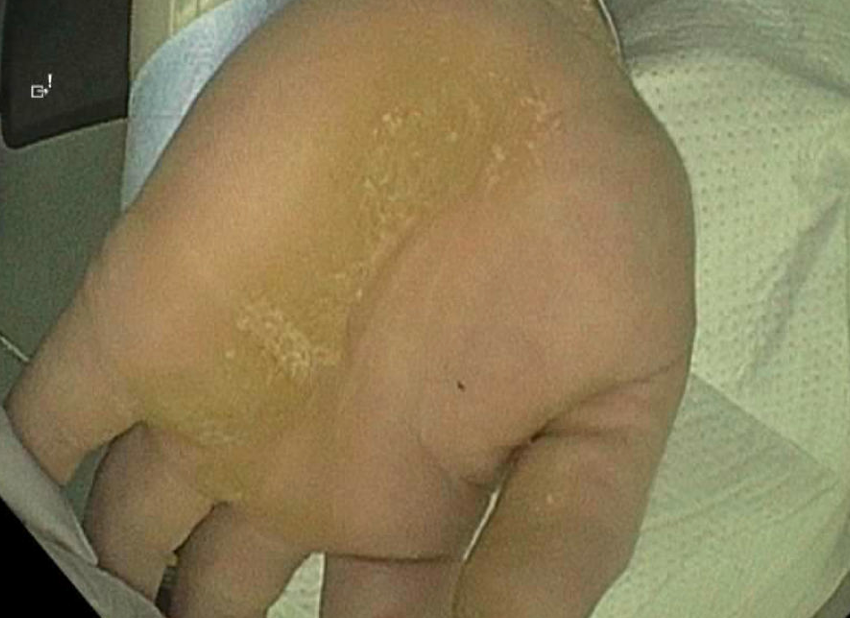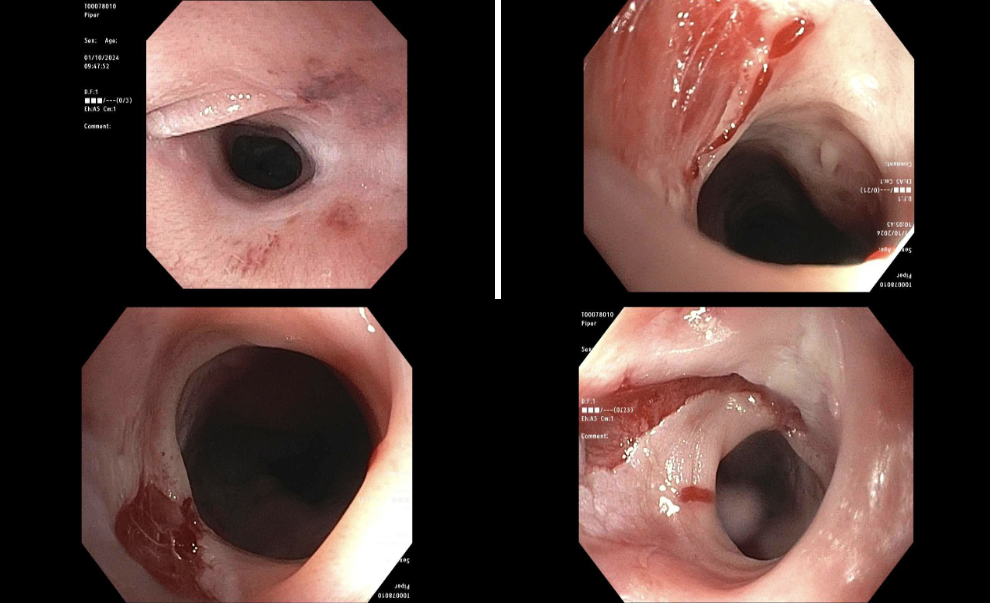Tuesday Poster Session
Category: Esophagus
P5004 - Recurrent Benign Esophageal Strictures in Tylosis: A Novel Clinical Association
Tuesday, October 28, 2025
10:30 AM - 4:00 PM PDT
Location: Exhibit Hall

Rukmoni Balasubramanian, MBBS (she/her/hers)
University of Connecticut
Farmington, CT
Presenting Author(s)
Rukmoni Balasubramanian, MBBS, Minh Thu T.. Nguyen, MD, Houman Rezaizadeh, MD
University of Connecticut, Farmington, CT
Introduction: Tylosis, or Howel-Evans syndrome, is a rare autosomal dominant disorder (affecting less than 1 in 1,000,000) characterized by palmoplantar hyperkeratosis and a markedly increased lifetime risk (up to 95%) of esophageal squamous cell carcinoma. To our knowledge, tylosis has not been reported in association with benign esophageal strictures. We present a unique case of a middle-aged man with tylosis and recurrent strictures requiring multiple dilations.
Case Description/
Methods: A 57-year-old man with hypertension, diabetes, and a 30-pack-year smoking history presented with heartburn and intermittent solid food dysphagia. Physical exam revealed bilateral palmar and plantar hyperkeratosis (Figure 1). Family history was notable for recurrent esophageal dilations and palmar hyperkeratosis in his mother. Initial EGD showed a benign-appearing, severe esophageal stenosis (9 mm diameter, 1 cm length) at 19 cm from the incisors and diffuse esophageal narrowing. Balloon dilation was performed and esophageal biopsies revealed squamous epithelium with hyperkeratosis and parakeratosis. A barium swallow showed short-segment strictures in the lower cervical and distal esophagus. One month later, repeat EGD showed multiple benign strictures requiring dilation. Multiple biopsies were negative for EoE or other etiologies. Over several months, he underwent nine EGDs at 4–8 week intervals for recurrent strictures, all requiring dilation. Given his presentation and family history, he was referred to genetics for suspected tylosis. RHBDF2 gene sequencing revealed a variant of uncertain significance, but the clinical suspicion for tylosis remained high. Due to the known risk of esophageal squamous cell carcinoma, annual surveillance EGDs with biopsies were recommended.
Discussion: This case highlights a novel presentation of tylosis with recurrent benign esophageal strictures—a previously unreported association. While literature links tylosis-related strictures primarily with malignancy, this case expands the spectrum by showing strictures in the absence of cancer. Early recognition is key due to the increased risk of malignancy. Genetic counselling and molecular testing, particularly sequencing of the RHBDF2 gene, are essential for diagnosis, even when a variant of uncertain significance is found. Management includes annual surveillance EGDs with biopsy and multidisciplinary care involving dermatology and genetics for thorough evaluation and risk stratification.

Figure: Figure 1: Photograph of the patient’s hyperkeratotic palm.

Figure: Figures 2.1–2.4: Strictures observed in the upper third of the esophagus
Disclosures:
Rukmoni Balasubramanian indicated no relevant financial relationships.
Minh Thu Nguyen indicated no relevant financial relationships.
Houman Rezaizadeh: AstraZeneca – Wife is employee there, Stock Options, Stock-publicly held company(excluding mutual/index funds). Bristol Meyers Squibb – Grant/Research Support. Celgene – Grant/Research Support. CellDex Therapeutics – Grant/Research Support. Cryoscope medical – Grant/Research Support. Regeneron – Advisor or Review Panel Member, Advisory Committee/Board Member, Consultant, Grant/Research Support, Speakers Bureau. Sanofi – Advisor or Review Panel Member, Advisory Committee/Board Member, Consultant, Grant/Research Support, Speakers Bureau. Skope Inc – Consultant, Intellectual Property/Patents, Stock Options, Stock-privately held company.
Rukmoni Balasubramanian, MBBS, Minh Thu T.. Nguyen, MD, Houman Rezaizadeh, MD. P5004 - Recurrent Benign Esophageal Strictures in Tylosis: A Novel Clinical Association, ACG 2025 Annual Scientific Meeting Abstracts. Phoenix, AZ: American College of Gastroenterology.
University of Connecticut, Farmington, CT
Introduction: Tylosis, or Howel-Evans syndrome, is a rare autosomal dominant disorder (affecting less than 1 in 1,000,000) characterized by palmoplantar hyperkeratosis and a markedly increased lifetime risk (up to 95%) of esophageal squamous cell carcinoma. To our knowledge, tylosis has not been reported in association with benign esophageal strictures. We present a unique case of a middle-aged man with tylosis and recurrent strictures requiring multiple dilations.
Case Description/
Methods: A 57-year-old man with hypertension, diabetes, and a 30-pack-year smoking history presented with heartburn and intermittent solid food dysphagia. Physical exam revealed bilateral palmar and plantar hyperkeratosis (Figure 1). Family history was notable for recurrent esophageal dilations and palmar hyperkeratosis in his mother. Initial EGD showed a benign-appearing, severe esophageal stenosis (9 mm diameter, 1 cm length) at 19 cm from the incisors and diffuse esophageal narrowing. Balloon dilation was performed and esophageal biopsies revealed squamous epithelium with hyperkeratosis and parakeratosis. A barium swallow showed short-segment strictures in the lower cervical and distal esophagus. One month later, repeat EGD showed multiple benign strictures requiring dilation. Multiple biopsies were negative for EoE or other etiologies. Over several months, he underwent nine EGDs at 4–8 week intervals for recurrent strictures, all requiring dilation. Given his presentation and family history, he was referred to genetics for suspected tylosis. RHBDF2 gene sequencing revealed a variant of uncertain significance, but the clinical suspicion for tylosis remained high. Due to the known risk of esophageal squamous cell carcinoma, annual surveillance EGDs with biopsies were recommended.
Discussion: This case highlights a novel presentation of tylosis with recurrent benign esophageal strictures—a previously unreported association. While literature links tylosis-related strictures primarily with malignancy, this case expands the spectrum by showing strictures in the absence of cancer. Early recognition is key due to the increased risk of malignancy. Genetic counselling and molecular testing, particularly sequencing of the RHBDF2 gene, are essential for diagnosis, even when a variant of uncertain significance is found. Management includes annual surveillance EGDs with biopsy and multidisciplinary care involving dermatology and genetics for thorough evaluation and risk stratification.

Figure: Figure 1: Photograph of the patient’s hyperkeratotic palm.

Figure: Figures 2.1–2.4: Strictures observed in the upper third of the esophagus
Disclosures:
Rukmoni Balasubramanian indicated no relevant financial relationships.
Minh Thu Nguyen indicated no relevant financial relationships.
Houman Rezaizadeh: AstraZeneca – Wife is employee there, Stock Options, Stock-publicly held company(excluding mutual/index funds). Bristol Meyers Squibb – Grant/Research Support. Celgene – Grant/Research Support. CellDex Therapeutics – Grant/Research Support. Cryoscope medical – Grant/Research Support. Regeneron – Advisor or Review Panel Member, Advisory Committee/Board Member, Consultant, Grant/Research Support, Speakers Bureau. Sanofi – Advisor or Review Panel Member, Advisory Committee/Board Member, Consultant, Grant/Research Support, Speakers Bureau. Skope Inc – Consultant, Intellectual Property/Patents, Stock Options, Stock-privately held company.
Rukmoni Balasubramanian, MBBS, Minh Thu T.. Nguyen, MD, Houman Rezaizadeh, MD. P5004 - Recurrent Benign Esophageal Strictures in Tylosis: A Novel Clinical Association, ACG 2025 Annual Scientific Meeting Abstracts. Phoenix, AZ: American College of Gastroenterology.
